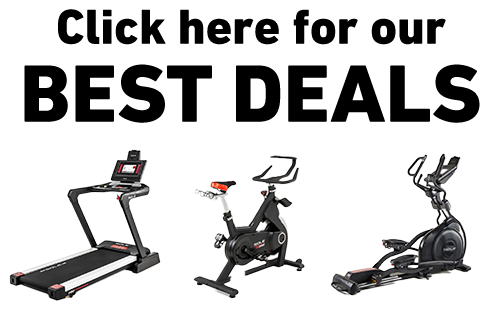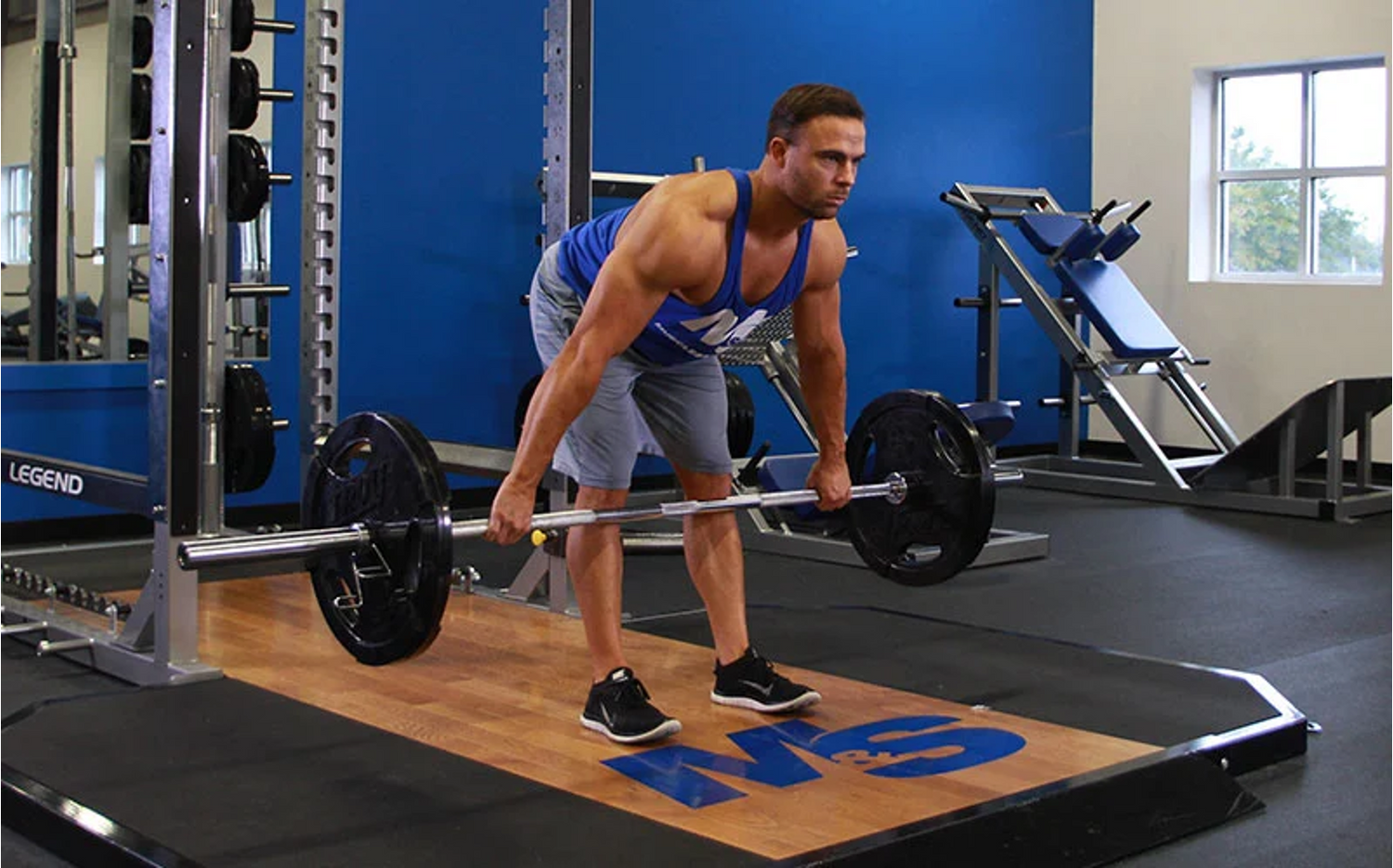Key Takeaways
- Stiff Leg Deadlifts hammer your lower back and hamstrings more, while Romanian Deadlifts (RDLs) focus on your glutes and hamstrings.
- RDLs let you bend your knees a bit, which saves your lower back from potential doom.
- Stiff Legs can make you crazy flexible in your hamstrings because of the deeper stretch.
- Both exercises require proper form to prevent injury and gain all their benefits.
- SOLE Olympic Barbell and adjustable dumbbells provide the perfect tools for mastering both deadlift variations at home.
Differences Between Stiff Leg Deadlift and RDL
Starting Position
Where you start sets the tone for each exercise. In the Stiff Leg Deadlift (SLDLs), you begin with the barbell on the floor, similar to a conventional deadlift. You lift the barbell from the ground with minimal knee bend. This requires a strong focus on maintaining a straight back to prevent injury.
The Romanian Deadlift (RDL) begins with the barbell already in your hands, lifted from a standing position. The knees are slightly bent from the start, which allows for a more controlled descent and working of the hip hinge movement. You're basically just lowering the weight and bringing it back up, never touching the ground.
Knee Bend
In the SLDL, your knees remain almost fully extended throughout the movement and stay almost locked the entire time; hence, the “stiff leg.” This puts tons of tension on your hamstrings and lower back.
But for RDL, you keep a slight bend in your knees the whole time. It doesn't look much different, but that tiny bend shifts some of the work from your back to your glutes and makes the whole thing less likely to wreck your back.
Range of Motion
For the SLDL, you go deep. The bar typically touches the floor (or close to it), giving your hamstrings a stretch that feels like they might snap. That's good for flexibility but can be scary for beginners.
In RDL, you stop when you feel a good stretch in your hamstrings, usually around mid-shin level. No need to touch the floor. This controlled range means you can focus more on the muscles working instead of just trying to reach the ground.
Weight Handling
The RDL often lets you lift heavier loads due to its reduced range of motion and more stable starting position. This makes it an excellent choice if you are looking to increase your strength and muscle mass.
Stiff leg deadlifts, while often performed with lighter weights, focus more on muscle endurance and flexibility. This doesn't mean you can't lift heavy with stiff leg deadlifts, but they are more challenging and put more stress on your lower back.
|
At SOLE, we're proud to offer top-quality exercise equipment designed for home and gym use. Our machines are built to meet the highest standards of durability and performance, making them ideal for fitness enthusiasts at any level. SOLE Products
|
Benefits of Each Exercise
Stiff Leg Deadlift Advantages
Hamstring Flexibility: If you can't touch your toes, SLDLs might be your new best friend. The deep stretch in this exercise can dramatically improve your hamstring flexibility over time.
Lower Back Strength: While this can be a risk if done wrong, when done right, SLDLs really strengthen your lower back muscles. A strong back means better posture and less back pain from sitting at your desk all day.
RDLs maintain a slight bend throughout, while SLDLs keep knees almost locked, creating different muscle emphasis and flexibility demands. (Image courtesy of IFAST Fitness)
More Range of Motion: Going from floor to standing means more work for your muscles through a fuller range. This can translate to better muscle development if you can handle the extra challenge.
RDL Advantages
Glute Focus: That slight knee bend shifts more of the work to your glutes. If building a perky booty is your goal, RDLs deliver the goods.
Lower Back Safety: The reduced range of motion and slight knee bend make RDLs generally safer for your lower back. This is huge if you've ever had back issues or are worried about developing them.
Hip Hinge Mastery: RDLs are all about that hip hinge movement, which carries over to tons of other exercises and daily activities. Master this, and your entire lower body training gets better.
Heavier Loads: Since you can typically lift more with RDLs, you can progressive overload more easily, which is key for building strength and muscle.
Targeted Muscles
Hamstrings and Glutes
Stiff Leg Deadlifts absolutely work your hamstrings due to the greater stretch and minimal knee bend. Your glutes still work, but they're not the star of the show.
RDLs still crush your hamstrings, but the slight knee bend brings your glutes to the party in a bigger way. If you want a balanced development between hamstrings and glutes, RDLs are your friend.
Lower Back Engagement
Stiff Leg Deadlift: Your lower back works overtime with SLDLs. This can be good for building strength but can increase your risk of injury if your form isn't perfect.
RDL: Still works the lower back, but with less stress thanks to the knee bend and typically shorter range of motion. It's the safer play for most people, especially beginners.
Core and Upper Back
Both exercises require your core and upper back to stabilize the weight and keep your spine neutral. Consider these bonus muscles that get worked while you're focusing on your lower body.
The beautiful thing is that your entire posterior chain (backside muscles) gets worked with both exercises, just with different emphasis depending on which variation you choose.
The hip hinge motion is crucial for both exercises. Imagine pushing your hips back while keeping your spine neutral, as if closing a door with your butt while holding something in front of you. (Image courtesy of KETTLEBELL MONSTER™)
Choosing the Right Exercise
Pick Stiff Leg Deadlifts If:
- You really need to work on hamstring flexibility.
- You want to strengthen your lower back specifically.
- You're comfortable with your deadlift form and have no back issues.
- You want a greater challenge in the range of motion.
Pick Romanian Deadlifts If:
- You want to focus more on building your glutes.
- You have lower back concerns or previous injuries.
- You're newer to deadlifting and want a safer option.
- You want to lift heavier weights for more strength gains.
- You're trying to improve your hip hinge pattern for other exercises.
Safety and Form Considerations
Regardless of which exercise you choose, proper form is absolutely vital. Here's how not to screw it up:
- Keep your back neutral (not rounded) throughout the entire movement.
- Hinge at your hips, don't just bend over.
- Keep the bar close to your body the whole time.
- Engage your core like someone's about to punch you in the stomach.
- Look forward or slightly down, not up at the ceiling or down at your feet.
Start with lighter weights to master the form before going heavy. Your back will thank you.
Progression Strategies
Progression is the secret to getting all the benefits of both the SLDL and the RDL. As you become more comfortable with the exercises, here's how to keep making gains:
- Start with light weights and focus on feeling the right muscles working.
- Gradually increase weight by 5–10% when you can do 10–12 reps with perfect form.
- Try variations like single-leg versions for an extra challenge.
- Play with tempo; slow down the lowering phase for more muscle tension.
- Add resistance bands or chains for variable resistance.
Perfect Your Hip Hinge with SOLE's Premium Strength Tools
Forget struggling with bent bars at your local gym. SOLE strength collection transforms your hip hinge exercises from awkward to awesome. The SW111 Olympic Barbell features specialized knurling that grips without grinding your hands into callused mitts. Its 194,000 PSI tensile strength means zero whip during your heaviest sets, critical for maintaining that perfect back position during both RDLs and Stiff Legs.
The SOLE SW111 Olympic Barbell's balanced weight distribution and specialized knurling creates the perfect platform for both deadlift variations.
Just getting started? The SW180 Adjustable Dumbbells let you perfect your form before tackling the barbell. Start with light dumbbell RDLs to master the hip hinge pattern, then gradually increase weight without cluttering your space with multiple dumbbells. The quick-adjust system means you can instantly drop weight if your form starts slipping.
Space-conscious? The compact SOLE SRVO All-in-One Trainer delivers constant tension throughout both deadlifts, something free weights physically can't provide. This means your hamstrings and glutes stay engaged even at the top position, accelerating your gains without the lower back stress of conventional training.
SOLE fitness equipment comes with the free SOLE+ app.
The SOLE+ App walks you through the subtle differences between these two powerful exercises, showing exact foot placement, knee bend angles, and bar paths. You'll learn when to use each variation for your specific goals: flexibility, glute development, or overall posterior strength.
Frequently Asked Questions (FAQs)
Which exercise is better for beginners?
For beginners, the RDL is often recommended due to its reduced risk of lower back strain. The slight knee bend in the RDL provides more stability and control, making it easier to learn the hip hinge movement.
However, beginners can also perform SLDLs with lighter weights and a focus on proper form.
Can these exercises prevent injury?
Both the SLDL and the RDL can help prevent injury by strengthening the muscles in the lower back, hamstrings, and glutes. Stronger muscles provide better support and stability, reducing the risk of strains and sprains.
However, improper form or excessive weight can increase the risk of injury. Always prioritize technique and consult with a fitness professional if you're unsure about your form.
How often should I perform these exercises?
For most people, performing these exercises 1–2 times per week is sufficient to see improvements in strength and flexibility. This frequency allows for adequate recovery while still providing enough stimulus for muscle growth.
Listen to your body and adjust the frequency based on your individual needs and goals. If you experience excessive soreness or fatigue, consider reducing the frequency or intensity of your workouts.
What equipment is needed for these exercises?
Both exercises can be performed using a barbell, dumbbells, or kettlebells. Choose the equipment that you feel most comfortable with and that best suits your fitness level and goals.
How does SOLE equipment make RDLs and SLDLs more effective than standard gym gear?
SOLE strength equipment enhances both RDLs and SLDLs through premium barbells with specialized knurling, quick-adjust dumbbells for progressive training, and the innovative SRVO for constant tension, giving you everything needed to build hamstring flexibility and glute strength in one home setup.



Leave a comment
This site is protected by hCaptcha and the hCaptcha Privacy Policy and Terms of Service apply.